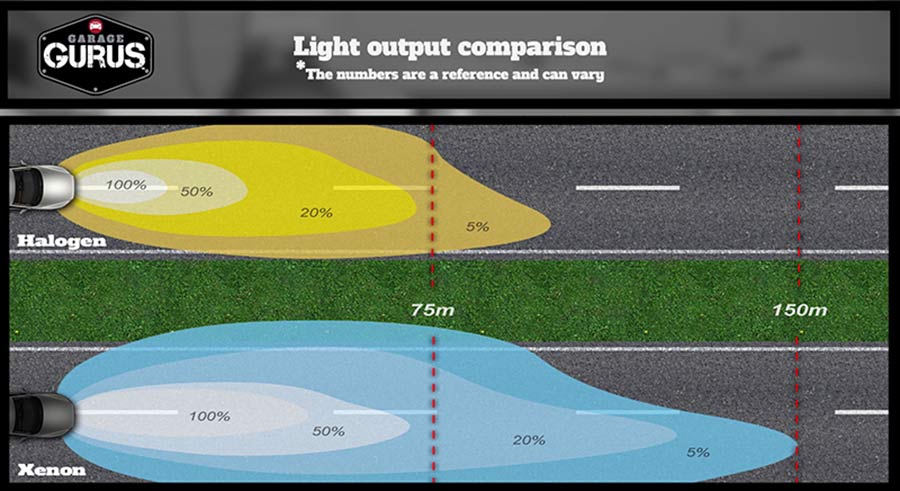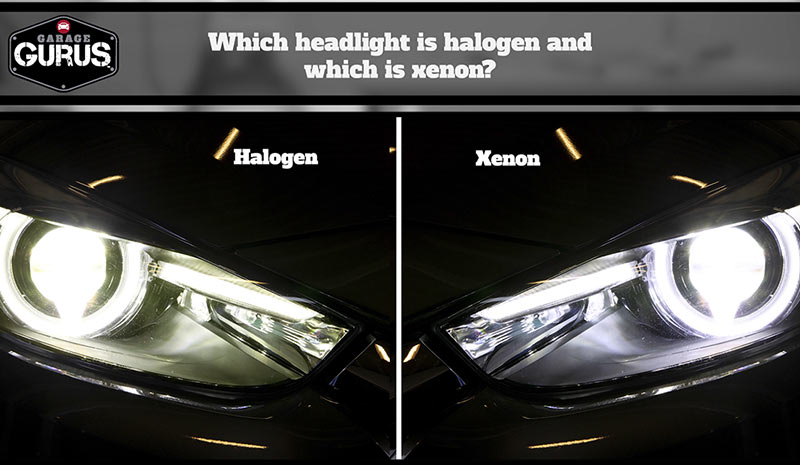 United Kingdom (English)
United Kingdom (English)
How many differences between halogen and xenon headlights do you know? How do each type of headlight work? And which gives you a larger range of vision in the dark? Check and refresh your knowledge with this Garage Gurus guide.
What are halogen headlights?
Halogen headlights are cheap to manufacture, easy to replace, give a bright light and last up to 3000 hours – which explains why they’re installed in 80% of the cars on the road today.
How do halogen headlights work?
A halogen light bulb consists of a thin tungsten filament surrounded by a halogen gas in a glass capsule which is resistant to extremely high temperatures. When voltage is applied, the filament glows and metal (tungsten) evaporates from the filament.

The halogen gas lets the filament temperature rise until it almost at the melting point of tungsten (3400°). The result is a high output of light. It has the side effect of extending the lifespan of the bulb.
The evaporated tungsten forms a gas which mixes with the halogen gas in the lightbulb and forms tungsten halogenide. When the gas particles come close to the filament, a tungsten layer is formed again due to the extremely high temperatures.
What are xenon headlights?
Also known as High-Intensity Discharge (HID) lamps, xenon lights are becoming popular on high-end cars, giving them a premium, exclusive look.
How do xenon headlights work?
A xenon lightbulb is a transparent quartz housing with tungsten electrodes at each end. It is filled with a mixture of gases. A xenon lightbulb works in three steps:
- Ignition. A high voltage pulse is used to create a spark inside the lightbulb. This ionizes the xenon gas and creates a tunnel of current between the tungsten electrodes.
- Initial heating. The arc is operated at high power and the temperature within the capsule rises quickly. The resistance between the electrodes drops. At which point the ballast registers the reduced resistance and switches to continuous operation.
- Continuous operation. The arc has now attained its stable shape and the produced light has attained its nominal value. The ballast now supplies stable electrical power so the arc will not flicker.

Halogen vs. Xenon headlights
Now we’ve seen how the two types of headlights work, let’s take a look at the main differences between them.

- Light output
Xenon headlights are more than twice as bright as halogen ones – 3200 lumens compared to 1500 lumens – which is why xenon headlights illuminate more of the road than halogen ones. However, halogen headlights are more effective in foggy weather conditions. - Energy efficiency
The overall difference in energy efficiency is so small that you probably won’t notice it. Halogen headlights use less energy than xenon to start-up, but they require more energy to keep going. Xenon headlights use gas as its energy source, so less electricity is needed. - Lifespan
Xenon headlights don’t last as long as halogen headlights – approximately 2,000 hours for xenon headlights, compared to 3,000 hours for halogen[CM1] . - Cost
Halogen are the clear winner here. They’re usually cheaper than xenon headlights to produce, purchase, install and repair. - Colour
Xenon headlights have a light blue colour (4000-6000K), which is similar to natural daylight, and halogen headlights are a yellow-orange colour (3200-5000K), which is warmer. - Installation
Installing halogen headlights is straightforward – they just click into position. Installing xenon headlights is a little more complicated as you need both a ballast and a mandatory light washer. - Construction
It’s always a good idea to be careful when handling headlights. Halogen bulbs can be weakened by grease from your bare hands, which can result in it breaking. Additionally, some xenon headlights contain toxic substances, such as metal mercury, which has a negative impact on human health if they break. - Safety vs. glare
Studies show that drivers have faster and more accurate reactions to road situations with xenon headlights compared to halogen ones. However, the brightness of xenon headlights can dazzle other drivers, so it’s important to use your automatic beam levelling control. - Start-up times
Halogen headlights are at full brightness from the second they’re turned on, while xenon headlights require a few seconds to warm-up to full brightness.
Important notes for installers
When installing halogen headlights, remember:
- In cars with plastic headlight glasses, only use UV-resistant halogen lamps (recognisable by “UV3 on the packaging or an “U” on the side) or the plastic will discolour.
- Never touch halogen lights with your bare hands. The natural grease on your hands could weaken the headlight, causing it to break.
And, when installing xenon headlights, remember
Xenon headlights operate under high voltages, so be aware of this danger when servicing xenon lights.
Discover more with Garage Gurus
Want to know more? Watch a Garage Gurus expert as he demonstrates the differences between halogen and xenon headlights.
For informational purposes only. We are not liable for any damages resulting from your reliance on this content.

































